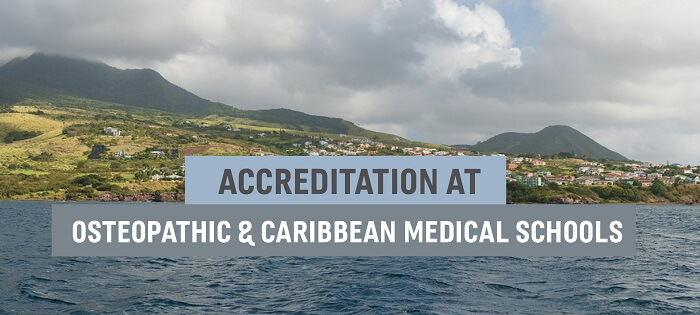Accreditation at Osteopathic and Caribbean Medical Schools
Osteopathic medical schools are accredited by a different organization from the allopathic medical schools. The American Osteopathic Association’s Commission on Osteopathic College Accreditation (COCA) conducts on-site visits, generates reports and evaluates how well the schools are meeting their expectations. COCA meets annually to update their standards. They met last June; you can read the updated changes here: They evaluate the schools in 12 major areas:
1. Mission and Governance
2. Leadership and Administration
3. Finances
4. Facilities
5. Learning Environment
6. Curriculum
7. Faculty and Staff
8. Scholarly Activity
9. Students
10. Graduate Medical Education
11. Program and Student Assessment and Outcomes
12. Institutional Accreditation.
Each standard has several elements. For example, Standard 5: Learning Environment has four elements: Professionalism, Diversity, Safety, Health and Wellness and Patient Care Supervision. According to the COCA website, there are no DO medical schools currently on probation, nor do they provide any information on the history of each school’s accreditation status. There are four new schools with provisional accreditation:
• Arkansas College
• Burrell College
• Liberty University
• University of the Incarnate Word
There are two main types of Caribbean medical schools, off-shore and regional. There are five off-shore Caribbean schools:
• American University of Antiqua
• American University of the Caribbean
• Ross University
• Saba University
• St. George’s University
They accept American and Canadian students. The regional schools are not all accredited and may not prepare students to practice in the U.S. since their goal is to graduate physicians to practice in those areas.
The Caribbean Accreditation Authority for Education in Medicine and other Health Professions (CAAM-HP) evaluates all medical, vet and dental programs in the Caribbean. The National Committee on Foreign Medical Education and Accreditation (NCFMEA) is part of the U.S. Department of Education, and it uses the findings of the CAAM-HP to allow students to participate in rotations, complete residencies and become licensed to practice in the U.S.
According to the CAAM-HP website:
• American University of Antiqua, Accredited with Conditions, 2014-2017
• American University of the Caribbean, Accredited with Conditions, 2014-2017
• Ross University, Accredited with Conditions, 2014-2018
• St. George’s University, Accredited with Conditions, 2015-2019
All of these schools have issues that they need to address, which explains why they are accredited “with conditions.” There are no schools that have the status, “Accredited,” on the CAAM-HP site.
Since Saba University is located on a special municipality of the Netherlands, it is accredited by the Accreditation Organization of the Netherlands and Flanders. The Medical Board of California, New York, Florida, and Kansas all accept the degree it grants.
The accreditation status of the medical school that you choose to attend can have long term consequences. Make sure that you do your own research and make the decision to apply with your eyes wide open. If you’re willing to take the risk, the schools with accreditation issues do tend to accept students with lower scores since they may receive fewer applications.
[xyz-ihs snippet=”Navigating-Med-Maze”]
[xyz-ihs snippet=”Signature-Code—Alicia”]
Related Resources:
• Osteopathic Application Tips Series
• Medical School Application Strategy: MD vs. DO Programs
• What Does it Mean for a Medical School to be on Probation?

